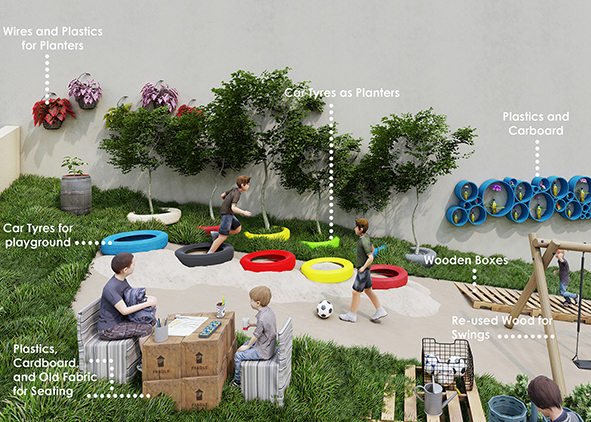Human-made. Waste as a resource for urban regeneration in Jabal al Jofeh refugee camp
DOI:
https://doi.org/10.19229/2464-9309/9132021Keywords:
urban regeneration, solid waste recycling, social integration, Jabal al Jofeh, refugee campAbstract
The paper deals with the use of waste as a resource for urban regeneration and social integration of marginalised communities in Amman (Jordan) through the case study of the Jabal al Jofeh refugee camp, a poor ‘informal’ area with a Palestinian refugee population characterised by high crime, unemployment and poverty rates. The proposed Urban Regeneration Plan focuses on the use and reuse of accumulated waste as construction material and on the creation of a neighbourhood network for the collection, sorting and recycling of waste and its transformation into saleable products that generate income for the community. The vulnerable area of the camp is thus transformed into an active connection with the culturally rich historic centre of Amman through a human-centred approach to urban design and planning, creating a sustainable micro-economy with people as its main resource.
Downloads
Article Metrics Graph
References
al-Husseini, J. (2011), “L’évolution des camps de réfugiés palestiniens en Jordanie – Entre logiques d’exclusion et d’intégration | The Evolution of the Palestinian Refugee Camps in Jordan – Between Logics of Exclusion and Integration”, in Ababsa, M. and Daher, R. (2011), Villes, pratiques urbaines et construction nationale en Jordanie, Presses de l’Ifpo, Beirut, pp. 181-204. [Online] Available at: doi.org/10.4000/books.ifpo.1742 [Accessed 21 March 2021].
Alhyasat, A. G. (2012), Amman Green Growth – The Case of Landfill Gas Recovery and Power Generation. [Online] Available at: resource-recovery.net/sites/default/files/ammang1.pdf [Accessed 21 March 2021].
Asomani-Boateng, R. and Haight, M. (1999), “Reusing organic solid waste in urban farming in African cities – A challenge for urban planners”, in Smith, O. (ed.), Urban Agriculture in West Africa – Contributing to Food Security and Urban Sanitation, International Development Research Centre, Ontario, pp. 138-154.
Harra Initiative (2021), Harra Initiative Facebook Page. [Online] Available at: facebook.com/harrainitiative [Accessed 21 March 2021].
Harvey, D. (2019), Rebel Cities – From Right to the City to the Urban Revolution, Verso Press, London.
Hawkins, A., Assad, R. and Sullivan, D. (2019), Amman, Jordan – Citizens of Somewhere. [Online] Available at: refugeesintowns.org/amman [Accessed 21 March 2020].
Jordan Department of Statistics (2020), Population. [Online] Available at: dosweb.dos.gov.jo/population/population-2/ [Accessed 21 March 2021].
Jordan Green Building Council (2016), Your Guide to Waste Management in Jordan. [Online] Available at: mena.fes.de/fileadmin/user_upload/pdf-files/publications/Your_Guide_to_Waste_Management_in_Jordan.pdf [Accessed 21 March 2021].
Lefebvre, H. (1974), The Production of Space, Blackwell Publishing, Oxford.
Lynch, K. (1960), The Image of the City, The MIT Press, Cambridge.
Ministry of Environment (2020), Waste Sector – Green Growth National Action Plan 2021-2025. [Online] Available at: moenv.gov.jo/ebv4.0/root_storage/ar/eb_list_page/20022_jordan _waste_v02_rc_web.pdf [Accessed 10 March 2021].
Ministry of Environment (2017), A National Green Growth Plan for Jordan. [Online] Available at: greengrowthknowledge.org/sites/default/files/A%20National%20Green %20Growth%20Plan%20for%20Jordan.pdf [Accessed 21 March 2021].
Mubaderoon (n.d.), Mubaderoon – Enterprises for Social Change – Strengthening social enterprise initiatives to combat poverty and exclusion in Jordan. [Online] Available at: mubaderoon.org/en/ [Accessed 21 March 2021].
Newman, O. (1972), Defensible Space – Crime Prevention Through Urban Design, Macmillan, New York.
Pavanello, S. and Haysom, S. (2012), Sanctuary in the city? Urban displacement and vulnerability in Amman, Overseas Development Institute. [Online] Available at: cdn.odi.org/media/documents/7605.pdf [Accessed 22 March 2020].
Roversi, R., Cumo, F., D’Angelo, A., Pennacchia, E. and Piras, G. (2017), “Feasibility of municipal waste reuse for building envelopes for Near Zero-Energy Buildings”, in Brebbia, C. A. and Sendra, J. J. (eds), Energy and Sustainability VII, WIT Press, Southampton-Boston, pp. 115-125. [Online] Available at: doi.org/10.2495/ESUS170111 [Accessed 22 March 2020].
Suthar, S., Rayal, P. and Ahada, C. P. S. (2016), “Role of different stakeholders in trading of reusable/recyclable urban solid waste materials – A case study”, in Sustainable Cities and Society, vol. 22, pp. 104-115. [Online] Available at: doi.org/10.1016/j.scs.2016.01.013 [Accessed 22 March 2020].
Teferi, Z. A. and Newman, P. (2017), “Slum Regeneration and Sustainability – Applying the Extended Metabolism Model and the SDGs”, in Sustainability, vol. 9, issue 12, article 2273, pp. 1-16. [Online] Available at: doi.org/10.3390/su9122273 [Accessed 21 March 2021].
The Jordan Times (2017), “Amman needs more public spaces, better services”, in The Jordan Times, newspaper, 09/05/2017. [Online] Available at: jordantimes.com/opinion/editorial/amman-needs-more-public-spaces-better-services [Accessed 12 March 2021].
The Jordan Times (2016), “Police arrest 10 suspected drug dealers”, in The Jordan Times, newspaper, 08/08/2016. [Online] Available at: jordantimes.com/news/local/police-arrest-10-suspected-drug-dealers [Accessed 12 March 2021].
UN – General Assembly (2015), Transforming our world – The 2030 Agenda for Sustainable Development, document A/RES/70/1. [Online] Available at: www.un.org/ga/search/view_doc.asp?symbol=A/RES/70/1&Lang=E [Accessed 14 March 2021].
UNRWA – United Nations Relief and Works Agency (2020), Where We Work. [Online] Available at: unrwa.org/where-we-work/jordan [Accessed 12 January 2021].

Downloads
Published
How to Cite
Issue
Section
License
This Journal is published under Creative Commons Attribution Licence 4.0 (CC-BY).
License scheme | Legal code
This License allows anyone to:
Share: copy and redistribute the material in any medium or format.
Adapt: remix, transform, and build upon the material for any purpose, even commercially.
Under the following terms
Attribution: Users must give appropriate credit, provide a link to the license, and indicate if changes were made; users may do so in any reasonable manner, but not in any way that suggests the licensor endorses them or their use.
No additional restrictions: Users may not apply legal terms or technological measures that legally restrict others from doing anything the license permits.
Notices
Users do not have to comply with the license for elements of the material in the public domain or where your use is permitted by an applicable exception or limitation.
No warranties are given. The license may not give users all of the permissions necessary for their intended use. For example, other rights such as publicity, privacy, or moral rights may limit how you use the material.


















































































